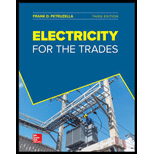
ELECTRICITY FOR TRADES (LOOSELEAF)
3rd Edition
ISBN: 9781260437454
Author: Petruzella
Publisher: MCG
expand_more
expand_more
format_list_bulleted
Question
Chapter 5.1, Problem 1RQ
To determine
Explain the purpose of using symbols in diagrams to represent components.
Expert Solution & Answer
Want to see the full answer?
Check out a sample textbook solution
Students have asked these similar questions
12.21 Determine iL(t) in the circuit of Fig. P12.21 for t ≥ 0,given that the switch was opened at t = 0 after it had been closedfor a long time, us = 12 mV, R0 = 5 W, R1 = 10 W, R2 = 20 W,L = 0.2 H, and C = 6 mF.
12.20 Determine uout(t) in the circuit in Fig. P12.20, given thatus(t) = 35u(t) V, uC1(0−) = 20 V, uC2 (0−) = 0, R1 = 1 W,C1 = 1 F, R2 = 0.5 W, and C2 = 2 F.
12.16 In the circuit of Fig. P12.16, us(t) is a rectangular 5-Vpulse of duration 3 seconds starting at t = 0. Determine iL(t) fort ≥ 0, given that R1 = 6 W, L = 1 H, and C = 13 F. Assume thatinitially the capacitor had no charge stored in it.
Chapter 5 Solutions
ELECTRICITY FOR TRADES (LOOSELEAF)
Ch. 5.1 - Prob. 1RQCh. 5.1 - Polarity markings are shown on symbols...Ch. 5.1 - Compare the type of voltage produced by a solar...Ch. 5.1 - Explain how circuit breakers and fuses protect a...Ch. 5.1 - What are the two basic functions of a switch?Ch. 5.1 - Compare the operation of a normally open and...Ch. 5.1 - What type of circuit component is a light bulb...Ch. 5.1 - In general, what is the function of resistors...Ch. 5.1 - Two wires are shown on an electrical diagram...Ch. 5.1 - Give one advantage and one limitation of the...
Ch. 5.1 - Explain why schematic diagrams are easier to read.Ch. 5.1 - What is a wiring diagram intended to show?Ch. 5.1 - Prob. 13RQCh. 5.1 - The one-line diagram is often used with a power...Ch. 5.2 - What best describes a simple circuit?Ch. 5.2 - A lamp is to turn ON when either one or the other...Ch. 5.2 - What connection of two or more switches can be...Ch. 5.2 - Three 120-V, 40-W incandescent lamps are connected...Ch. 5.2 - Two 12-V, 10-W lamps are connected in parallel to...Ch. 5.2 - A control system calls for a light to come on when...Ch. 5.2 - One bulb in a 20-string series-connected holiday...Ch. 5.2 - Prob. 8RQCh. 5.2 - Prob. 9RQCh. 5.2 - Prob. 10RQ
Knowledge Booster
Similar questions
- A rectangular waveguide with dimensions a = 2.5 cm, b = 1 cm is to operate below 15.1 GHz. How many TE and TM modes can the waveguide transmit? if the guide is filled with a medium characterized by σ = 0, ε = 4 εor fr = 1' Calculate the cutoff frequencies of the modes.arrow_forwardConsider the waveguide Calculate the phase constant, phase velocity and wave impedance for TE10 and TM11 modes at the operating frequency of 15 GHz. Answer: For TE10, 6 = 615.6 rad/m, u = 1.531 × 108 m/s, TE = 192.4. For TM11, B = 529.4 rad/m, u = 1.78 × 10° m/s, TM = 158.8 0.arrow_forwardAn air-filled 5- by 2-cm waveguide has Ezs = 20 sin 40лx sin 50лу eBz v/m at 15 GHz. (a) What mode is being propagated? (b) Find B. (c) Determine Ey/Ex. Answer: (a) TM21, (b) 241.3 rad/m, (c) 1.25 tan 40лx cot 50ду.arrow_forward
- Write the general instantaneous field expressions for the TM and TE modes. Deduce those TE01 and TM12 modes.arrow_forward2B: The relays of type ID_MT on The Feeders circuit breakers have a current setting of 125% CT ratio yoo/5 and atime multiplier setting of 400/5 0.5A three phase fault current of 5000A Flows through feeders, The characteristics of The relay given in atable for PS_M=1 calculate: Ⓒ Feeders relay current RSM and The actual operating time IF The Feeder supplied by transformer Find The TSM For The trans former overcurrent relay Take The discrimination time 0.5 sec. CT ratio 1000/ and CS-100% 10621.7 PSM: Time sec 2.2 20 16 12 2.5 2.75 3 3.8 10 12arrow_forwardDon't use ai to answer I will report you answerarrow_forward
- Don't use ai to answer I will report you answerarrow_forwardThe quantum efficiency of a pin-photodiode is 75 % at a wavelength of 1320 nm. The diode’s capacitance is 11 pF. For an input optical power of 1 mW, evaluate the mean (4)arrow_forwardDon't use ai to answer I will report you answerarrow_forward
arrow_back_ios
SEE MORE QUESTIONS
arrow_forward_ios
Recommended textbooks for you
 EBK ELECTRICAL WIRING RESIDENTIALElectrical EngineeringISBN:9781337516549Author:SimmonsPublisher:CENGAGE LEARNING - CONSIGNMENT
EBK ELECTRICAL WIRING RESIDENTIALElectrical EngineeringISBN:9781337516549Author:SimmonsPublisher:CENGAGE LEARNING - CONSIGNMENT Electricity for Refrigeration, Heating, and Air C...Mechanical EngineeringISBN:9781337399128Author:Russell E. SmithPublisher:Cengage Learning
Electricity for Refrigeration, Heating, and Air C...Mechanical EngineeringISBN:9781337399128Author:Russell E. SmithPublisher:Cengage Learning

EBK ELECTRICAL WIRING RESIDENTIAL
Electrical Engineering
ISBN:9781337516549
Author:Simmons
Publisher:CENGAGE LEARNING - CONSIGNMENT

Electricity for Refrigeration, Heating, and Air C...
Mechanical Engineering
ISBN:9781337399128
Author:Russell E. Smith
Publisher:Cengage Learning